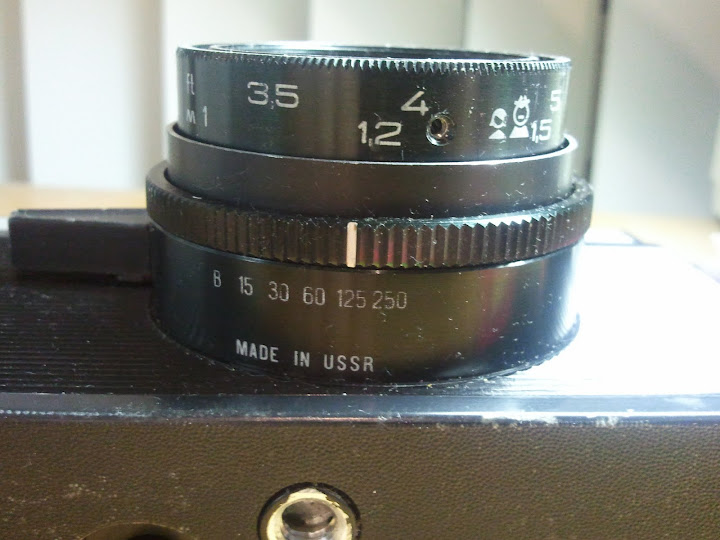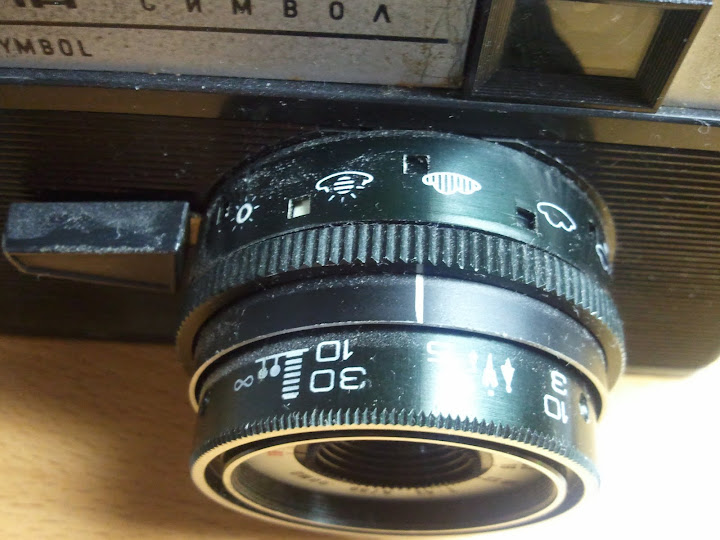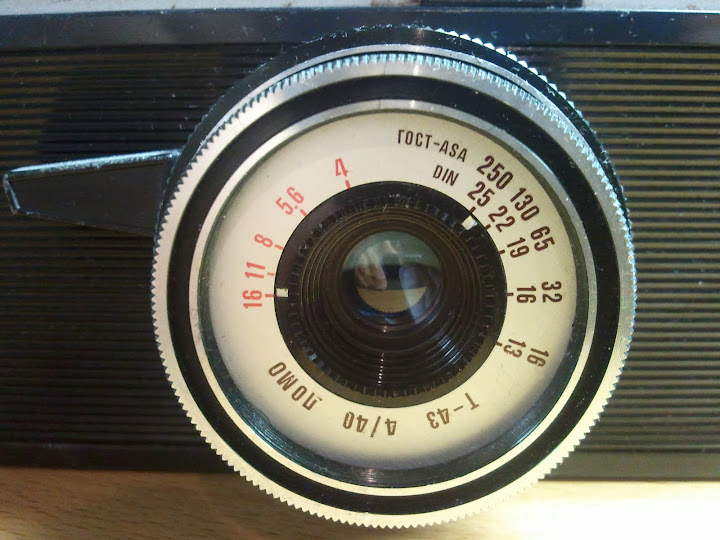
I know it’s been a long time coming, but here comes a new camera review!
My collection and types of cameras has vastly grown since my last review, partly because I keep buying new ones and partly because my friends have caught on to my photography fixation, and I’ve been getting obscure cameras for presents as well, which is neat.
Anyway, today I bring you the Smena Symbol, a 35mm camera which was the follow-up to the Smena 8M, with minor improvements. As yo
u have undoubtedly noticed by now, this is not a toycam in the slightest. Given that production of this beast of a camera started in 1973, I think I can safely classify it as vintage. The Symbol was my first foray out of the immensely fun point-and-shoot toycam photography and into what some might call “proper” photography. I don’t like to differentiate them like that, as both styles of photography have their pros and cons. Regardless, when I bought this, I found that I had no idea what settings to use in any given situation. But that was also part of the reason I deliberately chose to buy the Symbol, as you will soon see.
This camera has some very nice touches which made it a lot easier to get my head around these settings. Observe:

Bottom-up view
As you can see, with the outer ring, you can chose the shutter speeds. Your options are: Bulb, 1/15, 1/30, 1/60, 1/125 and 1/250. For those who are unsure what these numbers mean, they represent how long the shutter stays open. As they are actually fractions of a second, the larger the number, the faster the shutter speed. Now, most cameras would stop here and expect you to figure out how to use it yourself. Not the Symbol!

Top-down view
If you don’t like to deal with numbers, you can use these cute little weather symbols to determine the appropriate shutter speeds. Those little black squares fill in to demonstrate what setting you’re on. In the above images, the camera is set to 1/125, which correlates with that partly sunny symbol. My interpretations of the different symbols are: Sunny, partly sunny, partly cloudy, cloudy and there’s one more off the the right you can’t really see which I think is rainy.
As you can see in the photos, you can also adjust the focal length, ranging from 1.5m/5ft to ‘infinite’. There are also cool symbols to represent the different lengths, with a person representing the 1.5m option and trees for the infinite.

Aperture settings
One other setting you can change on this camera is the aperture. This is actually just one ring, showing three different scales. I’m not sure what the DIN and ASA are, but I just work off the aperture numbers (in red). The coolest part of this is that it’s actually continuous, in that you could technically have it set between two of the red markings and you’re not restricted to just the five steps.

Finally, as you can see, the camera is wound by a film advance lever, which makes it exceedingly easy to advance the film correctly. There’s also a film counter, but I don’t think mine is working properly. Oh yeah, there’s also a hotshoe, but I haven’t really used it much yet.
I found that the photos I took on my first roll were a bit hit-or-miss, but that was to be expected. That had absolutely nothing to do with the camera itself, but more to do with me experimenting with the settings. Despite that though, I was really quite happy with the photos that I got back. There really is something about this lens that is absolutely beautiful. I’ll upload photos as I find time.
Be aware that this camera is freaking heavy. I mean… every other company’s cameras got lighter as time went on, but I actually think Smena decided to make the Symbol even heavier than the 8M. This thing is a tank, so be prepared!
So if you’re like I was and are considering venturing out from point-and-shoot photography to something with more manual control, then do consider the Smena Symbol. I found that it was a great tool for coming to grips with things like shutter speed. Not only does it take 35mm film, there’s also the added benefit of owning something that says ‘Made in the USSR’. How awesome is that? Besides, that reminds me of the Beatles song.

hello,
i have also a smena symbol for a couple of days, can you help me with something?
when i turn the focus ring, it doesn’t stop, it keeps turning and turning e eventually detaching the lens, does it happen to you to?
LikeLiked by 1 person
No, that doesn’t happen with mine. When it gets to the 1 metre mark, it stops turning. I’m guessing that whatever inside that’s supposed to stop it is broken.
On the other hand, this could potentially give you a chance to take some really funky pictures. Unfortunately it’s not twin lens like the Gakkenflex, but you could potentially take macro-esque photos with it now, since you can turn the lens further than normal
LikeLiked by 1 person
thats right, i thought that it would be normal, since this is the way to change lens
thanks
LikeLike
Hello,
DIN = abbreviation for German Standard; ASA = abbreviation for American Standard and GOST = abbreviation for Russian Standard.
DIN, ASA(ISO) and GOST values figured on this camera represent the film speed. For instance, if you don’t know what aperture to select/set, just check the speed of your film before inserting it in the camera and set it with the help of the ring that also sets the aperture…
LikeLiked by 1 person
Aaaah thank you! That’s one less mystery in my life now. 🙂
LikeLike
Hi, i got this camera from my grandfather and iam still learning how to use but some say that you need a flash to take pictures with in non-sunny days like in rainy and cloudy dayes ,
is that true or can i take photos with out a flash ???? please help me !!
LikeLiked by 1 person
Hmmmm, I manage to take photos in rainy/cloudy days without flash, but they can be a bit blurry. Just make sure you adjust the aperture correctly.
LikeLike
The Smena Symbol was the very first camera I owned – got it for my 8th birthday! They were still making them at that time… It was a swell camera and I learnt a lot about photography through using it.
On the whole usage concept – the reason there is a single ring for aperture control and film speed is this: you are meant to set the film speed first, then take a reading of the f-stop the other white index is pointing at. E.g. in your photo above, you have set a film speed of 24 DIN / ASA 200, which in today’s terms means you’ve loaded the camera with an ISO 200/24° film. The other white index on the same ring is now pointing at the f/14 mark. The designers’ idea was that you’d shoot your entire roll at that aperture setting, and vary the shutter speed according to the prevailing weather conditions – hence the symbols. Of course if you know your way around photography and know that by opening up the aperture by one stop you can (and should) use a shutter speed that’s twice as fast, you can forget about the symbols and use the Smena Symbol like any other all-manual camera (you can even carry a hand-held light meter with you and set the measured values on the camera like a pro!). Of course a top shutter speed of 1/250th of a second means you oughtn’t to use a very fast film outdoors as it will likely get overexposed.
If you aren’t using a light meter and simply go by the symbols or the Sunny f/16 rule, you’ll probably want to use a negative that has a wide exposure latitude, like Kodak Portra 160.
TIP: If you keep the shutter release depressed after exposing a frame and advance the film while the shutter release is still being depressed, the camera will fire again! If you have a fast thumb, you can shoot at up to 2 frames per second, the experts say (never tried this).
LikeLiked by 1 person
Thanks so much for your insight from your experiences! I really, really need to try that double exposure trick of yours when I get time. I had no idea you could do something like that.
LikeLike
Just to clarify, this is not double exposure in the sense most people would use the term – i.e. it’s not about exposing two images on the same frame. What I was referring to was kind of a “continuous shooting” feature that might allow you to capture different phases of the same movement on different frames (similarly to a digital camera, or a film camera with a motor winder), just slower. This could be fun for photographing a street dancer or a sportsman diving from a springboard – but of course it’s kind of wasteful of film too.
LikeLike
Aaaah yes. Sorry, I totally misread what you wrote. Still, it’s a handy trick to keep in mind. I wonder if it works for all my other cameras too……
LikeLike
I have a Smena 8M and have posted a few tips on loading film here: http://sjp.id.au/oldgear/loading-film-into-a-smena-8m/
Are the differences between the 8M and the Symbol fairly negligeble?
LikeLike
It looks to be very similar, but I’ve never had any issues with loading or winding the film. Maybe they fixed a few of the issues for the Symbol?
LikeLiked by 1 person
It’s entirely possible. I’ll compare once my Symbol arrives. The counter on mine is useless really, but I have since found that the film winder does work fine, so far 🙂
LikeLike
Heyy, i’ve found with mine the shutter button/lever doesn’t always work, does this happen to you at all?
LikeLike
Hey, unfortunately (or fortunately) I haven’t come across that issue yet. The only easy fix I can think of is to make sure the film is fully advanced?
LikeLike